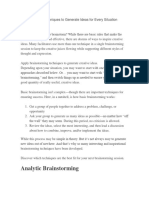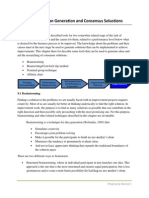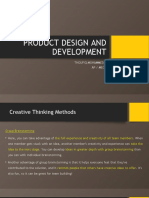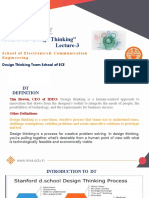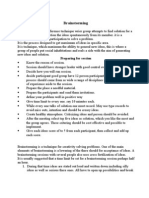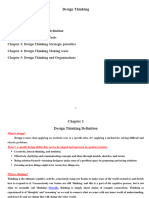Step 3: Ideating and Brainstorming
Step 3: Ideating and Brainstorming
Uploaded by
Rk PkCopyright:
Available Formats
Step 3: Ideating and Brainstorming
Step 3: Ideating and Brainstorming
Uploaded by
Rk PkOriginal Title
Copyright
Available Formats
Share this document
Did you find this document useful?
Is this content inappropriate?
Copyright:
Available Formats
Step 3: Ideating and Brainstorming
Step 3: Ideating and Brainstorming
Uploaded by
Rk PkCopyright:
Available Formats
Step 3: Ideating and Brainstorming
Ideation is a process of generating ideas for the solutions to the problems you have identified.
You’ll start with the questions you identified during the Define phase and challenge your team
to think broadly and with an open mind. This is where the true creative thinking happens. The goal
is not to find the best solution, it’s to think of as many solutions as possible, even crazy ones!
You’ll determine which ideas and solutions are the best later during prototyping and testing.
You will likely return to this phase again, after trying out some of your ideas. During the first
ideation round, focus on generating as many broad ideas as possible. As you’ve learned more
about what works and what doesn’t, your subsequent ideation rounds can become more narrow,
although you still want to keep minds open for ideas you had not thought of the first time.
Encourage your team to completely ignore obvious solutions and remind them that risk taking
and divergent thinking are valued—there are no bad ideas. This is also an important time to
harness the power of diversity and different perspectives, especially bringing in people who have
no experience in this area. The brainstorming lecture and worksheet offer additional strategies that
are important for any idea generation method.
There are a number of techniques to push your creative team to think WAY outside of the box.
For instance:
1) Add constraints, such as removing certain options or requiring others. For example, you could
ask the team to generate ideas based on the notion that there are no computers to use. Or, you could
encourage them to think of solutions that would lead to a 10 times improvement rather than a slight
improvement.
What constraints might you want to challenge your team with?
2) Ideating and Prototyping: You can also ideate and prototype at the same time, so ideas can
be put into immediate action and testing, even if they’re simply sketching or paper models.
Will you be ideating and prototyping concurrently? If so, how will you move between idea
generation and into prototyping?
3) Mind mapping, which we talked about in the creative thinking section, is another great tool for
ideation and it works well with groups or individually.
Look at the mind mapping activity and decide, will you be using this method?
4) Brainstorming, which we discuss in a separate video, is the ideal method for ideating. See
the attachment that accompanies the brainstorming video.
NARROWING IT DOWN
After you’ve brainstormed or otherwise generated your ideas, you will need to work with your
team to narrow down the list and identify the ones most likely to work, or most intriguing. This is
where you begin to evaluate the viability of each idea.
Voting Method: One simple method for this is to have each team member vote for their favorite,
or top 3 favorites, and explain their rational for their choice.
Story Mapping, which we used during the empathy phase and elsewhere, is great method for
narrowing down your list of ideas. Again, get out your sticky notes and divide a collaborate wall
into quadrants, asking team members to take the ideas they like best or that stand out and place
them into different categories. You can use the recommended categories or create your own:
The Rational Choice, The Most Likely to Delight, The Longshot, or The Most Unexpected. After
this, you may need to use the voting method to narrow ideas further.
Your categories (if different than the recommend categories:
The Rational Choice The Most Likely to Delight
The Longshot The Most Unexpected
In the end, you’ll want to carry forward multiple (usually 2 or 3) of the most promising ideas into
prototyping. Of course, you can prototype more, depending on the complexity of your ideas and
the type of prototypes. If there are too many good ideas to narrow down, select the ones that
represent the most extreme of each general type of idea. Prototyping these will help you determine
which direction is the most promising. You can always return to this phase later, after learning
more through prototyping and then testing.
How many ideas do you need your team to narrow down to?
What will you do to aid this, such as choosing extremes or voting to narrow further, if needed?
You might also like
- Brainstroming - EX - 7 Ui Ux Design Lab ExerciseDocument3 pagesBrainstroming - EX - 7 Ui Ux Design Lab ExercisemadhuarthickcseNo ratings yet
- The SCAMPER TechniqueDocument11 pagesThe SCAMPER Techniquemahwish112250% (2)
- Worksheet 4.13 ABCDE Disputation (Seligman, 2002) InstructionsDocument4 pagesWorksheet 4.13 ABCDE Disputation (Seligman, 2002) InstructionsChristopher JacksonNo ratings yet
- Class 4: Ideation Phase: Prototyping Overview of Ideation Phase: PrototypingDocument15 pagesClass 4: Ideation Phase: Prototyping Overview of Ideation Phase: Prototypingdreamer4077No ratings yet
- Choosing The Perfect Topic For A Research Project Can Feel OverwhelmingDocument5 pagesChoosing The Perfect Topic For A Research Project Can Feel OverwhelmingNelson BandoyNo ratings yet
- 01 Prepare For Brainstorming SuccessDocument7 pages01 Prepare For Brainstorming SuccessKaka D100% (1)
- Brainstorming Techniques To Generate Ideas For Every SituationDocument9 pagesBrainstorming Techniques To Generate Ideas For Every SituationShelvy RojasNo ratings yet
- What Is Brainstorming?Document2 pagesWhat Is Brainstorming?Yasmin khanNo ratings yet
- Idea Generation TechniquesDocument5 pagesIdea Generation TechniquesmansoormbaNo ratings yet
- Desgining AlternativesDocument38 pagesDesgining AlternativesAnishNo ratings yet
- 5 Techniques To Conduct A Successful Ideation ProcessDocument14 pages5 Techniques To Conduct A Successful Ideation ProcessJignesh RayNo ratings yet
- BrainstormingDocument6 pagesBrainstormingsyedasanaali6No ratings yet
- Step-3 Framing Issue at Hand.: Performing A Root-Cause AnalysisDocument4 pagesStep-3 Framing Issue at Hand.: Performing A Root-Cause AnalysistusharsatheNo ratings yet
- Design Process 3Document2 pagesDesign Process 3Ciara AnneNo ratings yet
- Brainstorming Process PDFDocument2 pagesBrainstorming Process PDFrajiNo ratings yet
- Definition of Creative Problem SolvingDocument8 pagesDefinition of Creative Problem SolvingUzwol KarnNo ratings yet
- Brainstorming TechniquesDocument4 pagesBrainstorming TechniquesImran Maqsood0% (1)
- 4.2 What Is BrainstormingDocument4 pages4.2 What Is BrainstormingD.K.Sreekantha NMAMIT - Computer Science & EngineeringNo ratings yet
- Brainstorming - Creativity Techniques FromDocument7 pagesBrainstorming - Creativity Techniques FromiinNo ratings yet
- What Is BrainstormingDocument3 pagesWhat Is BrainstormingMary MillareNo ratings yet
- How To Generate Clarity, Direction & Commitment To Organizational GoalsDocument20 pagesHow To Generate Clarity, Direction & Commitment To Organizational GoalsUdita Negi SrivastavaNo ratings yet
- Lecture 5Document23 pagesLecture 5kaveen khalilNo ratings yet
- Brainstorming Is A: Group Creativity Technique Ideas Problem Alex Faickney OsbornDocument19 pagesBrainstorming Is A: Group Creativity Technique Ideas Problem Alex Faickney OsbornАндрей СГNo ratings yet
- Tips For Structuring Better Brainstorming Sessions - InspireUXDocument7 pagesTips For Structuring Better Brainstorming Sessions - InspireUXJonathan Bates0% (1)
- Brainstorming!Document11 pagesBrainstorming!111111No ratings yet
- Decision Making TechniquesDocument6 pagesDecision Making Techniquesfathima.ahamed1926No ratings yet
- Innovation and EntrepreneurshipDocument11 pagesInnovation and EntrepreneurshipAppu AkNo ratings yet
- PGXPM-DT - DTC - Step 8 - Brainstorm IdeasDocument5 pagesPGXPM-DT - DTC - Step 8 - Brainstorm IdeasRajan13579No ratings yet
- Module 2Document27 pagesModule 2Adila KammadathNo ratings yet
- Brainstorming. Compiled by Ijaz HussainDocument10 pagesBrainstorming. Compiled by Ijaz HussainIjaz HussainNo ratings yet
- Tools For Idean Generation and Consensus Solustions: 9.1 BrainstormingDocument19 pagesTools For Idean Generation and Consensus Solustions: 9.1 BrainstormingSai BlazingrNo ratings yet
- Process of IdeasDocument4 pagesProcess of IdeasMarissa Caimol Aranda100% (1)
- Product Design and Development: Thoufiq Mohammed K Ap / MechDocument15 pagesProduct Design and Development: Thoufiq Mohammed K Ap / MechGokulCj GroveNo ratings yet
- Course On "Design Thinking" Lecture-3: School of Electronics& Communication EngineeringDocument22 pagesCourse On "Design Thinking" Lecture-3: School of Electronics& Communication Engineeringyann olivierNo ratings yet
- Design Thinking Slac PresentationDocument26 pagesDesign Thinking Slac PresentationArth Renier MinaNo ratings yet
- Nominal Group Technique & BrainstormingDocument20 pagesNominal Group Technique & BrainstormingAjayNo ratings yet
- ConvergeDocument12 pagesConvergeAdila KammadathNo ratings yet
- Engg 1011 CH 7 ConceiveDocument33 pagesEngg 1011 CH 7 ConceiveAu Cielo M. TINGOCIA100% (1)
- Class 4 - Worksheets - AccessibleDocument18 pagesClass 4 - Worksheets - Accessibledreamer4077No ratings yet
- CHAPTER 6 Ideate PDFDocument8 pagesCHAPTER 6 Ideate PDFAngeline Lagmay VisayaNo ratings yet
- 10 Tips For Effective Creative Brainstorming - Design ShackDocument8 pages10 Tips For Effective Creative Brainstorming - Design ShackraajmrkNo ratings yet
- BrainstormingDocument11 pagesBrainstormingMM J30No ratings yet
- BrainstormingDocument7 pagesBrainstormingDeepaNo ratings yet
- 7 Techniques For More Effective BrainstormingDocument8 pages7 Techniques For More Effective BrainstormingArshpreet KaurNo ratings yet
- Key Ideation TechniquesDocument3 pagesKey Ideation TechniquesSocrates FloresNo ratings yet
- Design Thinking Ideate To TestDocument6 pagesDesign Thinking Ideate To TestAditya KarnikNo ratings yet
- Concept of IdeateDocument26 pagesConcept of IdeateHarshavardhan KNo ratings yet
- Conducting A Brainstorming Session ChecklistDocument4 pagesConducting A Brainstorming Session ChecklistNilesh KurleNo ratings yet
- Sesi 9 - 10 (Exploring Ideation Techniques and Tools)Document63 pagesSesi 9 - 10 (Exploring Ideation Techniques and Tools)tandijonoalbertNo ratings yet
- B Ra Instorming: B Asic Tools For Process Im Provem EntDocument11 pagesB Ra Instorming: B Asic Tools For Process Im Provem Entskm_inNo ratings yet
- Brainstorm - 8 RulesDocument6 pagesBrainstorm - 8 RulesAbhilash Lodhi RajpootNo ratings yet
- Brainstorming Presentation 9709Document5 pagesBrainstorming Presentation 9709Nayan RathodNo ratings yet
- Brainstorming: Worksheet #179Document1 pageBrainstorming: Worksheet #179Jenny AngNo ratings yet
- CH 1, 2 D T DefinitionsDocument16 pagesCH 1, 2 D T Definitionswaleedyazeed111No ratings yet
- Brainstorming: Amritpal SinghDocument17 pagesBrainstorming: Amritpal SinghAnand RathourNo ratings yet
- Brainstorming: - K.Lalhruaitluangi Roll No-36 Sec-ADocument11 pagesBrainstorming: - K.Lalhruaitluangi Roll No-36 Sec-ARobert LalrinfelaNo ratings yet
- Assignment-2 (Design Thinking)Document12 pagesAssignment-2 (Design Thinking)ANURAG SHUKLANo ratings yet
- Decision Making ProcessDocument6 pagesDecision Making Processjein_amNo ratings yet
- chp3Document25 pageschp3prathmeshwavhal83No ratings yet
- Brain Storming TechniquesDocument25 pagesBrain Storming TechniquesMostafa Gamal El DeepNo ratings yet
- Brainstorming: How to Run a Storm Session, and How to Spot a Winning Idea (The Most Valuable Thinking Tools for Effective Work Performance)From EverandBrainstorming: How to Run a Storm Session, and How to Spot a Winning Idea (The Most Valuable Thinking Tools for Effective Work Performance)No ratings yet
- Step 4 Prototyping SolutionsDocument3 pagesStep 4 Prototyping SolutionsRk PkNo ratings yet
- What Is Unit Testing PresentationDocument6 pagesWhat Is Unit Testing PresentationRk PkNo ratings yet
- Pytest Overview PresentationDocument3 pagesPytest Overview PresentationRk PkNo ratings yet
- Initialize A Local Terraform ConfigurationDocument9 pagesInitialize A Local Terraform ConfigurationRk PkNo ratings yet
- What Are Hypervisors?: CPU / ProcessorsDocument8 pagesWhat Are Hypervisors?: CPU / ProcessorsRk PkNo ratings yet
- BasicsDocument4 pagesBasicsRk PkNo ratings yet
- Docker-Command NotebookDocument10 pagesDocker-Command NotebookRk PkNo ratings yet
- Smart Talk General Script Development FormDocument4 pagesSmart Talk General Script Development FormIrving Kelly B. PinedaNo ratings yet
- Love and Intimacy, Psychology Of: Panos Kordoutis, Panteion University of Social and Political Sciences, Athens, GreeceDocument7 pagesLove and Intimacy, Psychology Of: Panos Kordoutis, Panteion University of Social and Political Sciences, Athens, Greeceachmad fatoniNo ratings yet
- Mass Communication, Culture and Media LiteracyDocument4 pagesMass Communication, Culture and Media LiteracyMohamad Razali RamdzanNo ratings yet
- Who Controls Your Time - Oladele O. Olayemi EBook-1Document39 pagesWho Controls Your Time - Oladele O. Olayemi EBook-1quadrioriade5No ratings yet
- HUMSS - 1st QuizDocument2 pagesHUMSS - 1st QuizBrillantes JYNo ratings yet
- Self Efficacy Study Habits and TeachingDocument26 pagesSelf Efficacy Study Habits and Teaching53E GSMONo ratings yet
- Leadership Excellence July 2008Document22 pagesLeadership Excellence July 2008cristian cerolimiteNo ratings yet
- Autism-Baron Cohen The Emphathizing-Systemizing Es Theory - SBC - ARC-8-11Document4 pagesAutism-Baron Cohen The Emphathizing-Systemizing Es Theory - SBC - ARC-8-11AnaNo ratings yet
- Stress Management Mira&ChisnaDocument26 pagesStress Management Mira&Chisnaedy kurniawanNo ratings yet
- Creating Significant Learning FinkDocument77 pagesCreating Significant Learning FinkAdryan Fabrizio Pineda Repizo50% (2)
- Test Bank For Social Psychology 8th Edition by AronsonDocument45 pagesTest Bank For Social Psychology 8th Edition by Aronsona11736903050% (2)
- Final DraftDocument12 pagesFinal Draftapi-239530476No ratings yet
- Barkadahan: A Study Ofpeer Group and Values Among Filipino AdolescentsDocument18 pagesBarkadahan: A Study Ofpeer Group and Values Among Filipino AdolescentsCiara AnaNo ratings yet
- 8626 Assignment No 1Document56 pages8626 Assignment No 1Asad ullahNo ratings yet
- Dunphy Mullane Allen 2014Document5 pagesDunphy Mullane Allen 2014Ana Paula Melo LebreNo ratings yet
- Training Matrix RPMS TeachersDocument5 pagesTraining Matrix RPMS TeachersMichael Edward De VillaNo ratings yet
- Chapter 13 Speaking To InformDocument4 pagesChapter 13 Speaking To InformAtiqah NadirahNo ratings yet
- Operation MangementDocument3 pagesOperation MangementMuhammad ShahidNo ratings yet
- WK 14. Lewin - Erikson, KohlbergDocument31 pagesWK 14. Lewin - Erikson, KohlbergGhierome RomeroNo ratings yet
- Literature ReviewDocument9 pagesLiterature ReviewMuhammad AmirulNo ratings yet
- Learning Styles, Personality Types and Reading Comprehension Performance PDFDocument8 pagesLearning Styles, Personality Types and Reading Comprehension Performance PDFRoberto DantasNo ratings yet
- Virgenmilagrosasenior Highschool: 'Chapter IDocument18 pagesVirgenmilagrosasenior Highschool: 'Chapter INaomi Aira Gole CruzNo ratings yet
- Family Coping Index Part IiiDocument25 pagesFamily Coping Index Part IiiAira Shane MargesNo ratings yet
- A "We" in "Team" Investigation of Team Cohesion and Success in BaseballDocument23 pagesA "We" in "Team" Investigation of Team Cohesion and Success in BaseballArrah ArrieNo ratings yet
- Brahma Kumaris Daily ThoughtsDocument47 pagesBrahma Kumaris Daily ThoughtsMySecret Gardenmdp100% (1)
- Jonathan Tiglao PR Q1W3Document3 pagesJonathan Tiglao PR Q1W3jonas Tiglao100% (1)
- Sensation and PerceptionDocument12 pagesSensation and PerceptionKueni Mari100% (1)
- Cognitive Skills DVTDocument4 pagesCognitive Skills DVTPeterNo ratings yet
- BurnoutDocument11 pagesBurnoutLavinia DamianNo ratings yet






